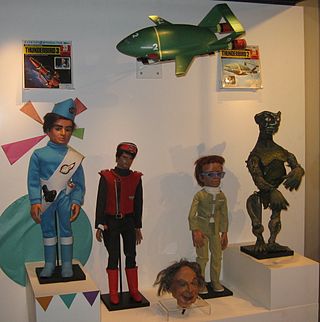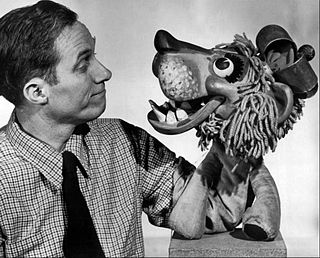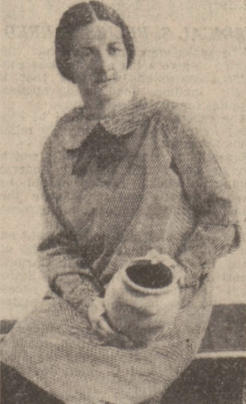
Supermarionation is a style of television and film production employed by British company AP Films in its puppet TV series and feature films of the 1960s. These productions were created by Gerry and Sylvia Anderson and filmed at APF's studios on the Slough Trading Estate. The characters were played by electronic marionettes with a moveable lower lip, which opened and closed in time with pre-recorded dialogue by means of a solenoid in the puppet's head or chest. The productions were mostly science fiction with the puppetry supervised by Christine Glanville, art direction by either Bob Bell or Keith Wilson, and music composed by Barry Gray. They also made extensive use of scale model special effects, directed by Derek Meddings.

Puppetry is a form of theatre or performance that involves the manipulation of puppets – inanimate objects, often resembling some type of human or animal figure, that are animated or manipulated by a human called a puppeteer. Such a performance is also known as a puppet production. The script for a puppet production is called a puppet play. Puppeteers use movements from hands and arms to control devices such as rods or strings to move the body, head, limbs, and in some cases the mouth and eyes of the puppet. The puppeteer sometimes speaks in the voice of the character of the puppet, while at other times they perform to a recorded soundtrack.

A marionette is a puppet controlled from above using wires or strings depending on regional variations. A marionette's puppeteer is called a marionettist. Marionettes are operated with the puppeteer hidden or revealed to an audience by using a vertical or horizontal control bar in different forms of theatres or entertainment venues. They have also been used in films and on television. The attachment of the strings varies according to its character or purpose.

Children's Fairyland, U.S.A. is an amusement park, located in Oakland, California, on the shores of Lake Merritt. It was one of the earliest "themed" amusement parks in the United States. Fairyland includes 10 acres (4.0 ha) of play sets, small rides, and animals. The park is also home to the Open Storybook Puppet Theater, the oldest continuously operating puppet theater in the United States.

William Britton "Bil" Baird was an American puppeteer of the mid- and late 20th century. He and his puppets performed for millions of adults and children. One of his better known creations was Charlemane the lion. He and his wife Cora Eisenberg Baird (1912–1967) produced and performed the famous puppetry sequence for "The Lonely Goatherd" in the film version of The Sound of Music. His son Peter Baird was also a puppeteer, and he continued his family's legacy until his own death in July 2004.
Ronnie Le Drew is a Canadian-born British puppeteer who was born in Toronto, Canada. He is best known for playing "Zippy" from the ITV children's show Rainbow since the early 1970s and trained at the Little Angel Theatre, London under John Wright. His association with the Little Angel spans over thirty years as performer, and later as director.
Nigel Plaskitt is an English actor, puppeteer, producer, and stage and television director.

Count Franz Graf von Pocci was a significant official in the court of King Ludwig the First of Bavaria, best known as the founding director of the Munich Marionette Theatre where he was a shadow puppeteer and wrote countless puppet plays and children's stories.

Peter Scriven MBE was an Australian puppeteer, writer and theatre producer, and the founding artistic director of the Marionette Theatre of Australia. Scriven played a huge role in establishing puppetry as a serious artform in Australia.

A puppet is an object, often resembling a human, animal or mythical figure, that is animated or manipulated by a person called a puppeteer. Puppetry is an ancient form of theatre which dates back to the 5th century BC in Ancient Greece.

Yoke thé is the Burmese name for marionette puppetry. Although the term can be used for puppetry in general, its usage usually refers to the local form of string puppetry. Like most of Burmese refined art, yoke thé performances originated from royal patronage and were gradually adapted for the wider populace. Yoke thé are almost always performed in the form of Burmese operas.
Sue Hastings was an American puppeteer known for popularizing the ancient art of puppetry in the 1930s and 1940s. She was a protégé of famous advertising artist and master puppeteer Tony Sarg. She was known as a society hostess and for performing with her large collection of professionally made marionettes, which she created with the assistance of her large team of artisan puppeteers. Her many renowned performing companies were headquartered in New York City, New York, USA. During the height of her career, as owner and CEO of Sue Hastings Marionettes, Inc., she reputedly, in her inimitable "hands-on" style, was actively and very successfully directing over 50 performing companies, some of which performed worldwide for heads of Royalty, such as Queen Elizabeth I, and many other dignitaries and distinguished national and international diplomats and world leaders.
Mak Wilson is a now retired English puppeteer, writer, CG animation director, and mocap artist. He is also known as Mac Wilson and Malcolm Wilson.

David Alan Barclay is a British puppeteer who had worked on some projects of The Jim Henson Company. He has been at the cutting edge of animatronic puppetry since 1979. Barclay, who hails from London, is a Master Puppeteer, Animatronic Designer and Supervisor, a CG key frame Animator, and Director and Producer of animatronic and animation projects for film and television.
The Lovelace Theatre was a puppet theater in Pittsburgh, Pennsylvania.
Waldo Sullivan Lanchester was a British puppeteer who founded the Lanchester Marionettes (1935–1962), a puppet theatre that was based in Malvern, and later in Stratford-upon-Avon. He wrote a book on the revival of puppeteering and commissioned George Bernard Shaw to write his last completed play Shakes versus Shav in 1949. In 1952, Donald W. Seager wrote that "Waldo Lanchester has consistently been associated with all that is best in the puppet theatre." Archibald Henderson called him "England's greatest puppetmaster."
The Lanchester Marionettes, a professional puppet theatre, was co-founded in 1936 by Waldo and Muriel Lanchester. The 50-seat Lanchester Marionettes Theatre in Malvern, Worcestershire, England was “the only theatre in the country exclusively to be used for marionettes.” George Bernard Shaw’s final play, Shakes versus Shav, was written for the Lanchester Marionettes in 1949.
Louisa Till was an English American marionettist and entertainer active in the late 19th and early 20th centuries.
Randal John Metz is a professional puppeteer and variety/stage performer. He is known for creating puppet productions, and puppet performer for Children’s Fairyland’s Open Storybook Puppet Theater in Oakland, California, the oldest continuously operating puppet theater in the United States. He currently produces seven different puppet shows a year for the theater, and tours his shows throughout California under the name The Puppet Company. He has served several terms as President and Vice-President of the San Francisco Bay Area Puppeteers Guild.

Muriel Lanchester was a British ceramicist and co-founder of the puppet theatre company, the Lanchester Marionettes. Lanchester and her husband, Waldo were the first British people to appear on French television, as part of the World's Fair in Paris in 1937. George Bernard Shaw’s final play, Shakes versus Shav, was written for the Lanchester Marionettes in 1949.















